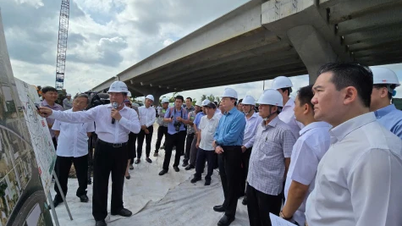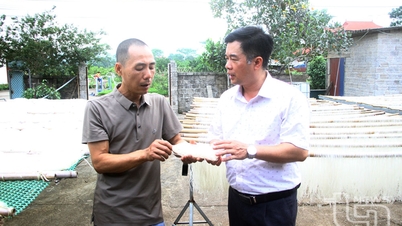 |
| Concrete pouring requires attention to maintenance to ensure the quality of the project. |
Reinforced concrete is a harmonious combination of concrete and steel. Accordingly, concrete has good compressive strength but poor tensile strength. Steel has good compressive and tensile strength. Reinforced concrete is a combination to help increase the compressive and tensile strength of concrete structures.
Mr. Ton That Tung Thanh, Head of Laboratory - Product Quality Control (Dong Lam Cement Joint Stock Company) shares some notes when constructing reinforced concrete floors:
Careless and insecure preparation and construction of support columns and formwork can easily lead to risks such as scaffolding collapse during construction, or can cause concrete to sink, swell, shrink in size or lose cement water during the pouring process. Therefore, formwork and support columns must be performed carefully and correctly, inspected and accepted before pouring concrete floors to avoid errors that affect the quality of the project.
The placement of steel bars and the connection of steel bars must be carried out under the guidance of an engineer or a technical officer with knowledge of the structure, and must comply with the regulations in TCVN 4453:1995. Incorrect placement of steel bars in the structure, especially at the intersections between beams and columns, will reduce the load-bearing capacity of the concrete floor; incorrect connection of steel bars can affect the durability of the structure.
Stirrups are steel rings wrapped around the main steel bars along beams/beams and columns. These stirrups have the role of keeping the main steel bars fixed during construction, withstanding strong compressive forces. At the same time, the stirrup layer withstands horizontal and diagonal shear forces, especially in the intersection areas between structural members. In addition, stirrups also resist expansion due to temperature changes in the concrete to help keep the concrete homogeneous. Normally, stirrup reinforcement is performed near the intersections. In case of high compressive forces, it is necessary to bend hooks to keep the main steel bars from slipping.
Misalignment of structural systems can cause serious problems during construction. Typically, structures that are not aligned or misaligned from the previous stage will cause misalignment when making steel or pouring concrete. Therefore, during construction, we need to have a solid grasp of basic knowledge of geometry and precise measurements to avoid unnecessary errors.
Nowadays, the process of selecting materials for concrete mixtures is easier and has more choices than before. The quality of sand and stone depends on the grain composition and the content of harmful impurities (mud, dirt, organic impurities). The quality of concrete depends a lot on the aggregate, so we need to choose aggregates that meet the quality requirements to prepare the concrete mixture.
Regardless of the method of mixing concrete, the concrete mix must be optimized for each use and designed to be most suitable and meet the required concrete grade. For civil cement, the mixes recommended by the manufacturer must follow the instructions on the packaging.
Using the appropriate amount of mixing water is an important note. With the same mix of cement, sand, and stone, the amount of water used is more or less to adjust the slump (mobility) of the concrete mixture for ease of construction. However, slump that is too high or too low can affect the quality of the concrete. Therefore, the slump needs to be adjusted appropriately for each construction item. Normally, the slump of the concrete mixture used for reinforced concrete floors is about 10±2cm (maximum 12±2cm when elevated) when using a concrete pump; the reasonable slump for foundation concrete poured directly without a pump is 6±2cm; the reasonable slump for columns and floors poured directly without a pump should be 8±2cm.
Nowadays, most concrete mixing is done using a domestic mixer or an industrial mixer (fresh concrete). Manual concrete mixing is often used when the volume of concrete is small. Common mistakes include:
Incorrectly weighed or measured raw materials (excess/shortage) change the concrete mix, resulting in a change in concrete quality compared to the design concrete grade requirements, affecting the quality of the project.
The concrete mixture is not homogeneous due to the mixing time being too short, resulting in the materials not being mixed evenly, reducing the workability and quality of the concrete. The concrete mixture after mixing is not constructed immediately, causing the quality of the concrete to decline because the cement hydration process has partially taken place.
Depending on the function of the floor or the floor area, the floor concrete can have different thicknesses and must comply with the design. Thin floor thickness can affect the load-bearing capacity of the floor when put into use; floors with excessive thickness cause waste, floor gravity can affect the load-bearing structures, affecting the foundation of the project. Ensuring the thickness of the floor concrete according to the design helps the floor to bear the load well, promote the effect of the reinforcement and protect the reinforcement. Therefore, it is necessary to note the height at each floor location, or prepare a probe with the required height to check during the floor concrete pouring process. More professionally, check the height during the concrete pouring process with a level and Mia machine.
When pouring pumped concrete, if the drop height is too high, it will cause stratification and separation of the concrete mixture on the floor, affecting the quality of the floor concrete (porous, poor waterproofing, weak strength, etc.). Therefore, it is necessary to limit the drop height as low as possible, the drop height should not exceed 1.5m to avoid stratification.
In actual construction, there may be complex scenes where the pump nozzle is difficult to adjust flexibly. To overcome this, we can use nozzles and inclined chutes to pour concrete. For concrete columns, we can open the horizontal formwork on the sides of the column, fill it up to there, reinstall the formwork and continue pouring the upper part. The process of pouring concrete on the floor must be poured from far to near the concrete receiving position to ensure that people and vehicles do not walk on the newly poured concrete structure.
Curing is very important to ensure the concrete is kept moist, to protect the concrete from rapid water loss and adverse effects during the initial curing of the concrete. Inadequate curing can cause cracks on the floor surface, white surface, and the concrete does not reach the design strength.
Source






























































































Comment (0)